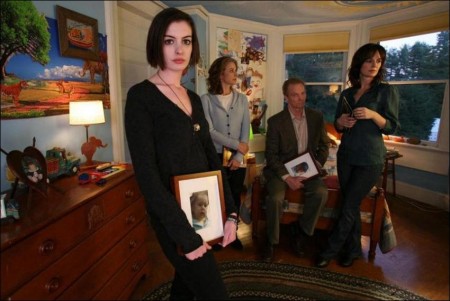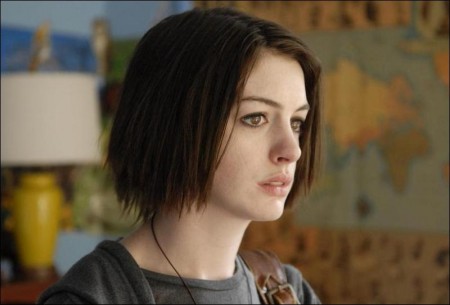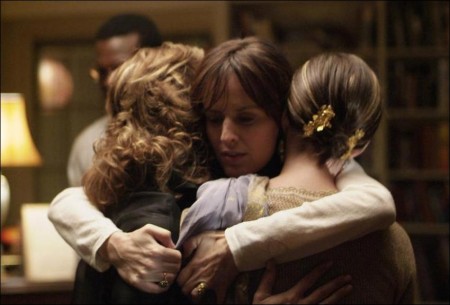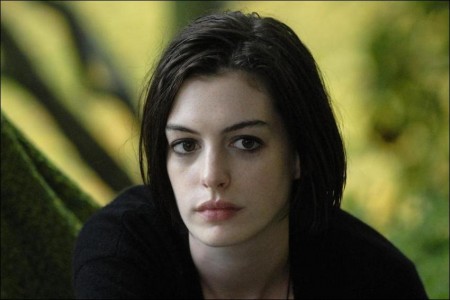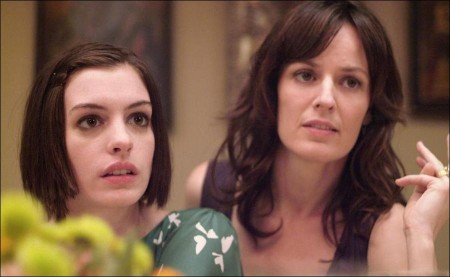When Kym (Anne Hathaway) returns to the Buchman family home for the wedding of her sister Rachel (Rosemarie Dewitt), she brings a long history of personal crisis and family conflict along with her. The wedding party’s abundant cast of friends and relations have gathered for an idyllic weekend of feasting, music and love, but Kym – with her black-humor and knack for bombshell drama – is a catalyst for long-simmering tensions in the family dynamic.
Filled with the rich and eclectic characters that have always been a hallmark of Jonathan Demme’s films, Rachel Getting Married paints a strikingly perceptive family portrait. Director Demme, first-time writer Jenny Lumet, and the stellar acting ensemble leaven the drama of these difficult but compelling people with wry affection and generosity of spirit.
Rachel Getting Married is a contemporary drama with an aggressive sense of humor about the return of an estranged daughter to the family home for her sister’s wedding. Kym’s (Hathaway) reemergence throws a wrench into the family dynamics, forcing long-simmering tensions to surface in ways both hilarious and heartbreaking. Rachel Getting Married paints a colorful, nuanced family portrait and is filled with the rich characters that have always been a hallmark of Jonathan Demme’s films.
About the Production
About ten minutes into Rachel Getting Married, there’s a moment when Kym (Anne Hathaway), newly returned to the Buchman family home, wanders down an upstairs hall and steps into a sunlit child’s room. Violin music drifts up the stairs from the musicians practicing below. Kym looks around the room for a few seconds, and moves on. Nothing happens—but the moment is powerful.
“I wanted something sad floating through there,” recalls producer/director Jonathan Demme. “I had my headphones on, looking at the monitor, and Declan was doing this beautiful shot: Kym turns around, starts from the camera, and that was Zafer Tawil’s cue downstairs to start playing. I heard that haunting music and saw Anne’s face respond. I went running after Zafer and said, “Zafer, what was that beautiful tune?” He said, “That’s what I composed for you.” So this rich musical theme was revealed to us as we were making the movie—and to Annie in character as Kym. It was all in the moment and there it is, onscreen.”
That spontaneity—capturing unrehearsed the moody chemistry of Zafer Tawil’s composition, Declan Quinn’s restless camera, and Anne Hathaway’s bereft gaze—was the guiding principle of the Rachel Getting Married production. “The looseness of Jenny’s script made me feel that this shouldn’t be a tightly directed movie,” says Demme. “At every step of the way, Jenny went to an unexpected place and went further and further off formula and never pulled back. I was really amused and intrigued by the fact that Jenny didn’t try to make you like these characters. They were smart, edgy, irritating and yet halfway through reading the script I felt like I had become part of the family and cared tremendously about all of them.
“There’s terrible trauma in this family, and yet the wedding is beautiful. I wanted Rachel Getting Married to explore both sides of that paradox—the dark struggle, and the celebration of love and family and friends.”
To portray those polarities, Demme, cast and crew took an unconventional approach to every aspect of the film’s production. Long, loosely staged scenes play out accompanied by live music; documentary-style camerawork and editing tell the story; and eminent actors mingle onscreen with movie novices, musicians, artists and dancers in a creative mix.
“We all agreed to let reality happen in front of the cameras without trying to manipulate it from behind the scenes too much. Consistent with that we didn’t do any rehearsals, and nobody, not even Declan, really knew what the shot was going to be until the take started taking shape.” As lengthy scenes played out from start to finish, Director of Photography Declan Quinn and his camera crew prowled the family home with handheld cameras, capturing on the fly the characters’ exchanges, speeches, big gestures, and small sidelong looks. The action moved forward with few takes and as little obtrusive preparation as possible.
“In the intimate scenes,” says producer Neda Armian, “there would be the main characters in gut-wrenching conversation—and Declan. He was almost like one of the actors, part crew and part cast, relying on his instincts, skill and confidence to know where to point the camera. I like to say this movie has Jonathan’s heartbeat and a lot of Declan’s blood.” (Or sweat—“That camera was heavy,” remarks Declan Quinn.)
Quinn relates, “The way we worked was very empowering to the cast, and brought the emotions to the surface. Even the crew had to look at things differently, because we all had to be on our toes and react in the moment. As the DP I don’t usually operate the camera myself, but it gave me the freedom to make immediate choices; I tried to see the action as a viewer in the room would—to put the audience in the midst of it.”
During the long wedding party scenes, strategic cameras were literally placed in the actors’ hands to augment the “pro” cameras: Gonzales Joseph, who plays Sidney’s cousin in uniform, is never seen without a small prosumer camera; indie filmmaker Jimmy Joe Roche is the official wedding videographer, and two of the digicam-wielding guests are Demme’s mentor Roger Corman and ace cinematographer Charlie Libin.
“There was such an atmosphere of trust,” says Anne Hathaway, who manages to bring wounded humanity to the unrelentingly difficult character of Kym. “Since we never knew when the camera was on us, the cast had to listen every second, and achieve a very intense level of focus. One of the lessons that the movie teaches—particularly for people in recovery— is how important it is to stay in the present. To be able to stay in character, and hear and react to the music and the scene around you, is very liberating for an actor. To me, this story is about communication and love—and we were given the latitude to explore that.”
“Something happens where you get to work and every corner of the house feels like a house and not a movie set,” says Rosemarie DeWitt, with a nod to production designer Ford Wheeler’s evocative creation of a beautiful and believable family home for the Buchmans.
An Oud on the Back Porch
Like the free-form shooting style, the music was an integral element played out with unconventional freedom. “For the longest time,” recalls Demme, “I’ve had this desire to try to provide the musical dimension of a movie without traditionally scored music. I thought: wait a minute, in the script, Paul is a music industry bigwig, Sidney’s a record producer, many of his friends will be gifted musicians, so of course there would be nonstop music at this gathering.
Following that logic, we have music playing live throughout the weekend, but always in the next room, out on the porch or in the garden.” Among the legion of musicians, dancers, and performers whom Demme enlisted to fill the ranks of the wedding party, jazz great Donald Harrison, Jr. and Palestinian virtuoso Zafer Tawil, contributed original throughline musical themes and are credited as composers (they also brought along plenty of accompaniment: Harrison‘s Grammy-nominated nephew Christian Scott shows up to jam at the reception, and Tawil is joined by an ensemble of players from the score of Jimmy Carter Man From Plains including Amir ElSaffar.)
“The musicians were encouraged to play whenever they were inspired to, the more the better, never paying attention to the rolling camera,” explains music supervisor and editor Suzana Peric’, who has worked on every Demme film since Something Wild. “Musical anarchy on the set. Bliss for the musicians, big headaches for those who had to record them.“
“At one point,” says Demme, “Anne Hathaway was trying to act out a very intense scene while the musicians noodled around outside. She was distracted and the assistant director came to me and said that she was having trouble, so I said “Tell her to do something about it, then.” That’s when Kym yells at them to shut up—all unplanned and improvised but completely in character.”
Crediting a lifetime in a complicated, artistic family for her screenplay’s perfect pitch, Jenny Lumet says “I’m a good listener” (and watcher—Sidney Lumet did engage once in a dishwasher-filling race—with Bob Fosse). Improvisation expanded on the script’s strikingly authentic dialogue.
For example, Bill Irwin describes how the actors tuned into “…Storytelling that wasn’t on the page. As scripted, my character Paul and Debra Winger’s character Abby, my ex-wife, hardly exchange any dialogue. But Debra and I followed our instincts, and enlarged that relationship without words, through gestures.” That’s the case when Paul and Abby briefly embrace and then pull apart at the end of their daughter’s wedding—a piercing moment for the viewer.
“There were things in the script that Jenny had written in a very pared-down style,” explains Demme. “At script level the wedding progressed through brief snapshot leaps in time. It was scripted that Sidney would sing a song but Rachel’s vows to Sidney weren’t scripted. I told the actors that they had to take us through a complete wedding, and incidentally, they had to stage it themselves. Rosemarie made up Rachel’s speech herself. Beau Sia, who helped plan the rehearsal dinner and wedding with Rosemarie and Anisa George (Emma), was an unscripted character imposed on the filming by casting Beau—an actor and poet I’ve been dying to work with—as kind of a “wedding czar emcee guy”.”
Rosemarie DeWitt points out, “There are times when you feel like Jonathan’s orchestrating everything and nothing at the same time,” an observation echoed by Bill Irwin: “Sometimes it seems like all he’s doing is smiling and making sure people feel good about work day after day. But he knows what he’s after and gets what he wants.”
The movie’s big set pieces, such as the rehearsal dinner, the wedding, and the reception dance party, are densely populated with a wide-ranging assemblage of Demme’s friends, family, colleagues, and other energizing personalities (see the following section, Friends, Musicians, and the Community Spirit for a detailed listing of participants).
“Every person, every face in the film is there for a reason,” says Armian. “Jonathan loves real people, and loves working with his friends, which creates a real camaraderie and ease. We were really having a wedding. I wasn’t a producer, I was a wedding planner. And he invited his friends.” Going local, most of the cast and crew were based in the New York area; “People actually went home at night and saw their families,” boasts Armian.
Beyond the fun factor of a convivial set, Demme explains, “One of the conceits of the script was that, despite the drama, the wedding goes great. Let’s face it, 12 the reason you can have a great wedding is because you get a bunch of people together who hit it off and have a great time at a once in a lifetime event. I couldn’t imagine how that could be “acted” by extras, so I felt that the best thing to do would be to get a fantastic group of people together who meet each other the way people will do. If it takes us five days to film the wedding, we’ll film it in continuity and everyone will get to know each other. At the end, when they are partying together, they really should be partying together.”
“Over the weekend,” continues Demme, “there are two different kinds of gatherings going on: people gathering to have fun at the wedding, and other people engaged collectively in the epic struggle against addiction, gathering together to gain strength from that community on a parallel track. We wanted to show maximum respect for that courage and honesty.”
Hathaway sees those qualities in Kym: “I love Kym’s almost compulsive need for honesty,” says Hathaway, “and how direct she is. Her timing may not be appropriate, but she’s trying so hard to get across the chasm of tragedy that separates her from her family. She’s trying every day to choose joy and sobriety. She’s fighting for her place in the family, trying to acknowledge and atone in her own way. At the end, maybe her sister Rachel understands her journey, and that acceptance is crucial.”
For all that it revels in love and friendship—and a great party—Rachel Getting Married is ultimately focused on that emotional honesty, right to the depths of Kym’s eyes as she hears the sad violin music wafting upstairs.
Production notes provided by Sony Pictures.
Rachel Getting Married
Starring: Anne Hathaway, Bill Irwin, Rosemarie DeWitt, Debra Winger, Anna Deveare-Smith, Mather Zickel, Victoria Haynes, Annaleigh Ashford
Directed by: Jonathan Demme
Screenplay by: Jenny Lumet
Release Date: October 3, 2008
MPAA Rating: R for language and brief sexuality.
Studio: Sony Pictures
Box Office Totals
Domestic: $12,785,570 (84.6%)
Foreign: $2,329,056 (15.4%)
Total: $15,114,626 (Worldwide)
